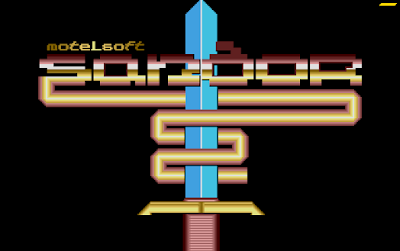From The CRPG Addict
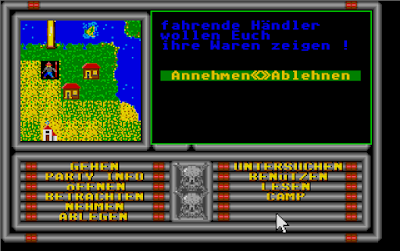 |
| A traveling merchant approaches the party in the land of Sandor. |
- Megrim. In English, this word means, “depression.” It’s a variant of migraine. Some dictionaries give an alternate definition as “low spirits,” and I wonder if some developer didn’t try to translate that exact phrase, thinking of the other kind of “spirit.” Or maybe someone bungled an anagram of “Grimm,” as in the fairy tales. I’m otherwise out of ideas. If it helps, Megrims get their highest rolls in intelligence and skill. Motelsoft got a lot of use out of the word. It was a race in Seven Horror’s; it appears in a title of a 1994 game, Escape from Ragor II: Megrim’s Rache; and it is the name of an NPC in Trauma 3D (2002).
- Hunch. From “hunchback,” maybe? They get high roles in strength and skill.
- Glonen. Maybe a play on klonen, “to clone”? Also appears to be a last name. They get low rolls in all attributes, making me wonder what they’re good for.
- Psychonaut. This term has been around from at least the 1970s to describe people who “explore altered states of consciousness.” Google suggests that the term has been used in numerous RPGs as a specialty class. I’m not sure if Sandor did it first. The class gets high rolls in everything but strength.
- Exane. I don’t even have a guess on this one. Attempts at Googling are overwhelmed by an investment bank of that name. The race or class gets high rolls in everything but endurance.
- Mensch. This is the only obvious one. It literally means “human” in German, and the race gets very balanced rolls with almost everything around 10.
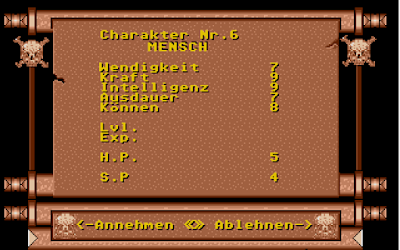 |
| Character creation. This guy’s a true mensch. |
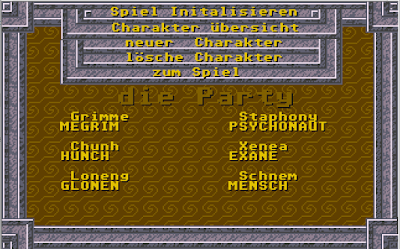 |
| I was lazy and went with anagrams for party names. |
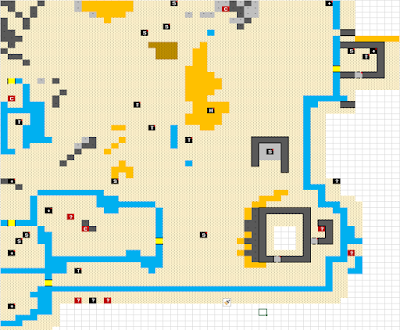 |
| The land so far. I screwed up one column or row somewhere, but it basically works. |
In a potentially ominous note, visiting the pub at a town near that gate brings up a message that “this is where the world ends for the freeware adventurer” and that to explore further, I need to order the full version by sending DM25 to Harald Breitmaier (one of the two listed developers) in Stuttgart. I got the game directly from Motelsoft, who doesn’t offer any option to register it on their web site. They didn’t respond to inquiries I sent about Seven Horror’s, so I don’t have a lot of optimism that they’ll respond on Sandor. I guess I’ll play until I can’t.
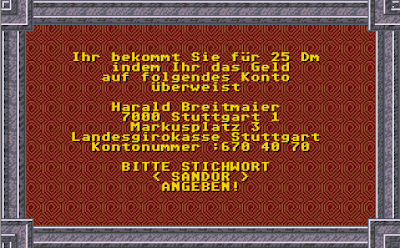 |
| DM25 in 1989 would have been $13.30, or about $27.00 today. |
Combat is far more advanced than Seven Horror’s, showing perhaps some of the influence of some SSI games. It doesn’t seem to draw from any previous European inspiration. After you’re told the composition of the enemy party (both type and level), you’re brought to an 8 x 10 grid, where every character has the ability to move, attack, cast a spell, use an item, get information about the enemies, pray, or pass. The entire party acts first, in some kind of initiative order, followed by the enemies. Each character has a number of points that he can use for both movement and other actions, so if you’re right next to an enemy, you can put all the points in attacking. This is quite similar to SSI’s Wizard’s Crown and Shard of Spring series.
 |
| For this fight, I face a dervish, a hellhound, a fire imp, and a brigand. |
This early in the game, I don’t have any spells or items, so it’s just been attacking. There have been some light tactics in anticipating the enemy’s movement and trying to get him to come to me rather than wasting all my action points approaching him. I’ve also learned to target spellcasters quickly because they have a tendency to summon other creatures.
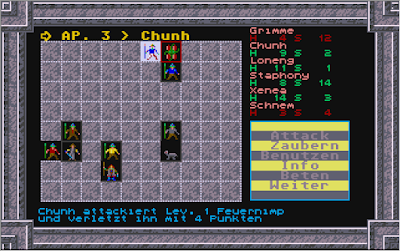 |
| My party members taking on four foes. |
Combat hasn’t been overwhelmingly common–maybe once every 30 moves. It has been quite deadly, however, and I’ve had to reload after about half of them. The difficulty of enemies is tied in part to the area of the map that you’re exploring, and I’ve been attacked by numerous parties that I was nowhere near ready to take on. Fortunately, the rarity of combat means that you can just reload and get out of those dangerous areas. It also means that you rarely face more than one combat per game day, and sleeping at night restores most hit points for a Level 1 party.
There are a variety of schools scattered around the land, where characters can literally spend intelligence points (and money) to learn skills like hunting, lockpicking, healing, and spellcasting. Some of the schools are duplicated, and some of the skills are offered in towns, and I’m not sure if there’s any difference among them. I haven’t found near enough money yet to get any of these skills.
 |
| A school. I can learn healing at this one. |
It’s the skill system that convinces me that the direct inspiration for Sandor is SSI’s Demon’s Winter (1988), which not only had the combat system from Shard of Spring but also had the same schools around the map. There are some analogies among the skills themselves. There are a lot of other little similarities, including the way markets offer one item at a time, the way you can get lore in pubs, the way that different towns offer different services, the various temples that try to convert your members, the spacing between encounters in the wilderness (Demon’s Winter had one every 43 moves, precisely), the requirement to find a guild to level up, and in general the top-down interface. Even some of the tiles and icons look similar. Demon’s Winter was a decent game, so no complaints there.
 |
| Unlike Demon’s Winter, Sandor is clear about how you advance through the items. |
Across the map, I found:
- Three dungeons. None of them have obvious names. I haven’t really explored any of them yet, but they use a top-down interface just like the outdoor areas.
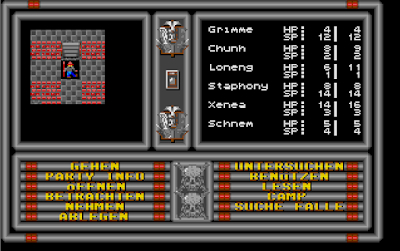 |
| What dungeons look like from the entrance. |
- Six towns. They all have three syllable names, and five of them (if I’m getting the pronunciation correctly) are dactyls: Kolono, Ulono, Nihili, Nalosa, Okokat, and Pelinos. Services vary by town, but among them you can find marketplaces, pubs, guilds (for leveling), skill schools, inns, and healers.
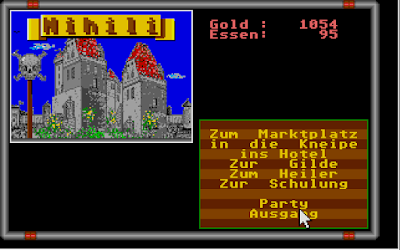 |
| This one town had all the services. |
- Nine skill schools: spellcasting, hunting, “opponent estimation” (analogous to Demon’s Winter‘s “Monster Lore”, I imagine), healing, resurrection, fighting, and locksmithing. There are some skills offered only in towns, and I’m not sure I’m translating them right: fallen-beseitigens (“fall-eliminating”?), schiffskunde, waffenkunde, and kartenkunde. I get the first words (“ship,” “weapon,” and “maps,” in order), but every dictionary I consult suggests kunde means “customer,” not “skill,” which you’d really expect there.
- Four “faith communities” (Glaubensgemeinschaft), three dedicated to the god Sunlot and one dedicated to Cenobit. Each gives me the opportunity to convert to that god; if I try to pray without converting, it says “you do not believe in this god!” I’ve kept the party neutral for now.
- Two weird places where a title screens says: “Holy Blood. Say no to evil.” Each character has the ability to “renounce”; if he does, a message says, “You are not in league with the devil.” Weird. I can’t remember if there was anything similar in Demon’s Winter, but I remember I never really understood churches and religions in that game.
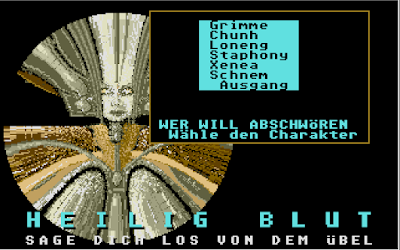 |
| I’ll be happy if I end the game knowing what this is about. |
- Three gates that I need some kind of “mage-gem” to pass, although one just lets me walk around it.
 |
| I’ll be back, I guess. |
- An old man’s hut. He wants the Wand of Urakus and threatens dire consequences should I return without it.
 |
| I think I’ll refrain from asking what the hell he’s laughing at. |
- A bunch of icons that look like collapsing castles or towers, but with nothing obvious to do there. Maybe they’re just visual.
During my explorations, I rose to Level 2, which comes with a satisfying increase in hit points and attributes. There are two guilds, on opposites ends of the map, for leveling. I almost have enough for Level 3. My finances are very slow to grow, however, and I hope that dungeons offer more in that area.
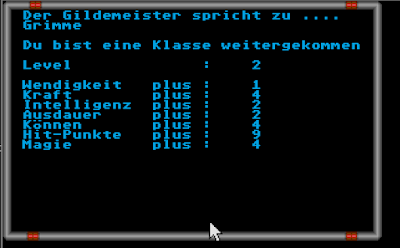 |
| Leveling up. |
On the plot, I’ve got nothing. The best I can go on is rumors from the pubs. A guy in Kolono told me about two caves in the west, and that I should not enter the first unless I have the Ring of Arcan, which I can get in the second. (I apparently need it to conquer some creature in the first.) Unfortunately, he didn’t tell me how I could distinguish the first and second caves.
Out in the wilderness, a “lone wanderer” named William Bacon said that his castle, “across the river,” was attacked by a “Jonge priest and his hordes.” His children were murdered and his wife imprisoned. He asked for my help and I said yes, but nothing else happened after that. This might go with another pub rumor about “hordes” to the east surrounding a city called Habata.
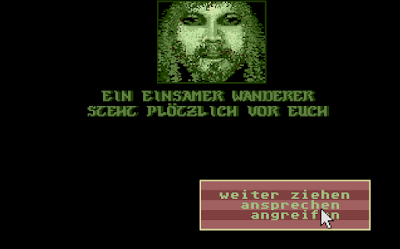 |
| Can you imagine attacking him? “Sorry, buddy; this just isn’t your week.” |
- Legends of the Lost Realm: Still can’t get anywhere with it. I’m basically waiting until I’ve scheduled several postings so I can spend time on it without worrying that I won’t have anything to blog about for more than a week.
- Le Maître Absolu: Weird French game based on the engine to Le Maître des Âmes (1987). It loads up the first time, but then every time I load it after that, it sits on a black screen. I might have something misconfigured in my Amstrad CPC emulator, which I don’t use all that often. Still comparing versions, testing, etc.
- Paladin’s Legacy. Ultima clone for the TSR-80 Color Computer. Gets stuck on the loading screen after character creation. There’s a web site where the creator says he had trouble with MAME (which is what I’m using) and recommends a different emulator. Have to download, test, etc.
- Sea Rogue. It’s an interesting simulation game about searching the seas for valuable shipwrecks. A commenter wrote 4 years ago and made an impassioned argument for the game as an RPG, and I admit it has some RPG elements. “Characters” (basically, people assigned to ship’s stations) get better through training and experience, and you get a kind-of inventory to make your explorations easier and more valuable. Combat, on the other hand, is all ship-to-ship (and not even a necessary part of the game), and overall it’s not really and RPG. I’d play it if I liked it, but I’m not much of a simulator fan. I gave it an hour and decided, with apologies to P.H., to scrap it.
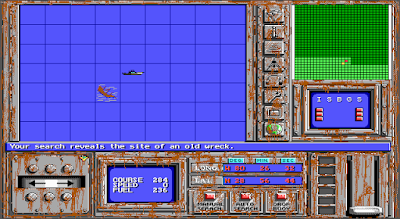 |
| Numbers and gauges typify the simulator approach to Sea Rogue. This is one of about nine stations on the ship. |
Original URL: http://crpgaddict.blogspot.com/2018/11/game-309-sandor-1989.html

